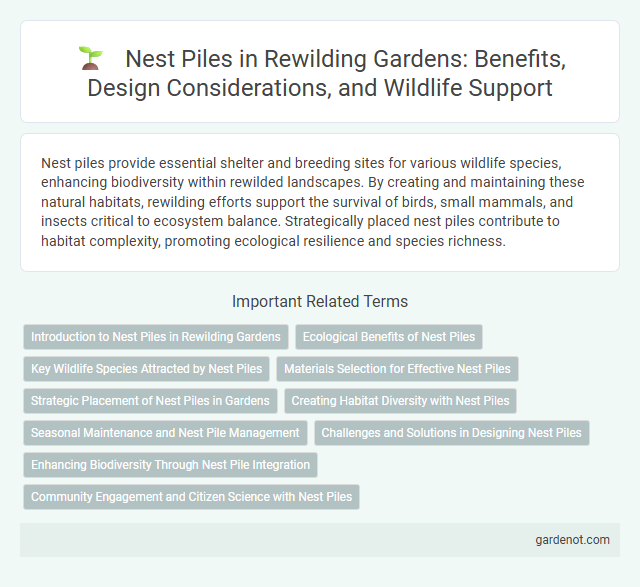Nest piles provide essential shelter and breeding sites for various wildlife species, enhancing biodiversity within rewilded landscapes. By creating and maintaining these natural habitats, rewilding efforts support the survival of birds, small mammals, and insects critical to ecosystem balance. Strategically placed nest piles contribute to habitat complexity, promoting ecological resilience and species richness.
Introduction to Nest Piles in Rewilding Gardens
Nest piles in rewilding gardens serve as essential habitats by providing shelter and breeding sites for birds, small mammals, and insects. These piles, composed of branches, leaves, and natural debris, mimic natural forest floor conditions, encouraging biodiversity and supporting ecosystem functions. Incorporating nest piles enhances habitat complexity, promoting species diversity and resilience in rewilded environments.
Ecological Benefits of Nest Piles
Nest piles provide essential shelter and nesting sites for a variety of wildlife, enhancing biodiversity by supporting species such as birds, small mammals, and insects. These structures contribute to habitat complexity, promoting natural behaviors and improving ecosystem resilience. By facilitating nutrient cycling and soil health through organic matter decomposition, nest piles play a crucial role in sustaining ecological balance within rewilding projects.
Key Wildlife Species Attracted by Nest Piles
Nest piles provide critical habitat for a variety of key wildlife species including small mammals like chipmunks and voles, as well as ground-nesting birds such as wild turkeys and quail. These structures offer shelter, nesting sites, and protection from predators, significantly enhancing biodiversity within rewilding projects. Amphibians and reptiles, including frogs and snakes, also utilize nest piles for cover, contributing to ecosystem resilience and species richness.
Materials Selection for Effective Nest Piles
Selecting appropriate materials for nest piles is crucial to support biodiversity and enhance habitat complexity in rewilding projects. Opt for native plant branches, logs, and leaf litter that provide shelter and nesting opportunities for birds, insects, and small mammals. Incorporating diverse natural materials improves microhabitat quality, promoting species richness and ecological resilience.
Strategic Placement of Nest Piles in Gardens
Strategic placement of nest piles in gardens enhances biodiversity by providing essential habitats for ground-nesting birds, insects, and small mammals. Positioning these piles near native shrubs or undisturbed areas maximizes shelter and breeding opportunities while promoting ecological connectivity within urban green spaces. Properly located nest piles contribute to rewilding efforts by supporting natural predator-prey dynamics and pollinator activity.
Creating Habitat Diversity with Nest Piles
Nest piles serve as critical microhabitats, fostering habitat diversity by providing shelter and breeding sites for various wildlife species such as birds, small mammals, and insects. These structures mimic natural debris accumulations, enhancing soil health and promoting plant regeneration through nutrient cycling. Incorporating nest piles in rewilding projects supports ecosystem complexity and resilience by increasing habitat heterogeneity.
Seasonal Maintenance and Nest Pile Management
Seasonal maintenance of a nest pile involves removing debris and insulating materials to ensure optimal nesting conditions for wildlife throughout the year. Regular nest pile management supports habitat stability by preventing mold growth and deterring invasive species, thereby promoting biodiversity. Monitoring temperature and moisture levels helps maintain a balanced microhabitat crucial for breeding success in rewilding projects.
Challenges and Solutions in Designing Nest Piles
Designing nest piles presents challenges such as ensuring structural stability, selecting appropriate natural materials, and accommodating diverse species' nesting behaviors. Solutions involve using durable, locally sourced wood combined with layered branches to mimic natural habitats and incorporating varying pile heights and densities to support multiple wildlife species. Monitoring and adaptive management enhance the effectiveness of nest piles by addressing site-specific environmental conditions and species requirements.
Enhancing Biodiversity Through Nest Pile Integration
Nest piles create essential habitats that support diverse bird and small mammal populations, fostering increased local biodiversity. Integrating nest piles into rewilding projects promotes natural nesting opportunities, enhancing species richness and ecosystem resilience. These structures also aid pollinators and insect populations, contributing to healthier soil and plant communities.
Community Engagement and Citizen Science with Nest Piles
Nest piles serve as critical habitats for various wildlife species, promoting biodiversity through community engagement initiatives. Citizen science projects involving nest pile monitoring enable local residents to contribute valuable data on species presence and behavior, enhancing ecological research. These collaborative efforts foster environmental stewardship and raise awareness about habitat restoration in rewilding landscapes.
Nest pile Infographic

 gardenot.com
gardenot.com